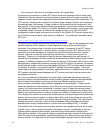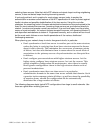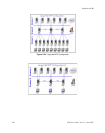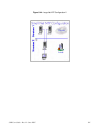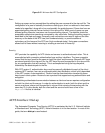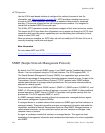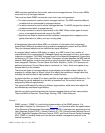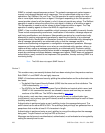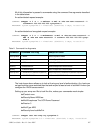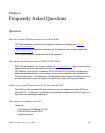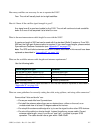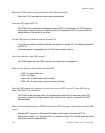
S100 User Guide – Rev. D – June 2005 105
2
5
3
NMS executes applications that monitor and control managed devices. One or more NMSs
must exist on any managed network.
There are four basic SNMP commands: read, write, trap, and operations:
• The read command is used to monitor managed devices. The NMS examines different
variables that are maintained by managed devices.
• The write command is used to control managed devices. The NMS changes the values of
variables stored within managed devices.
• The trap command is used to report events to the NMS. When certain types of events
occur, a managed device sends a trap to the NMS.
• Operations are used to determine which variables a managed device supports and to
gather information in tables, such as a routing table.
A Management Information Base (MIB) is a collection of information that is organized
hierarchically. MIBs are accessed using a network-management protocol such as SNMP.
They are managed objects and are identified by object identifiers.
A managed object (called a MIB object, an object, or a MIB) is one of any number of
characteristics of a managed device. Managed objects are comprised of one or more object
instances or variables. The SNMP manager is part of the Network Management System such
as Spectrum, HP Open View or Cisco Works. Information is traded between the NMS and the
network. NMS gathers, controls and monitors using information from the network. There are
three catagories: Statistics, Current Status and Alerts. Statistics (Traffic, CPU process) are
gathered and stored. Current Status data is monitored (i.e., links). Alerts are reports of any
unusual activity in the network.
There are two types of managed objects: single objects and multiple related objects. An
example of a single object is atInput, which is an object that contains an integer value that
indicates the total number of input packets on a router interface.
An object identifier (or object ID) uniquely identifies a single object in the MIB hierarchy. The
MIB hierarchy can be depicted as a tree with a nameless root, the levels of which are
assigned by different organizations.
The top-level MIB object IDs belong to different organizations, while lower-level object IDs
are allocated by associated organizations.
Vendors can define private branches that include managed objects for their own products.
There are MIBs for Ethernet, Token Rings, Routing, ATM, Frame Relay etc.
Version 1
SNMP version 1 (SNMP v1) was the first implementation of the SNMP protocol. It is
described in Request For Comments 1157 (
RFC 1157) and functions within the specifications
of the Structure of Management Information (SMI). SNMP v1 operates over protocols such as
User Datagram Protocol (UDP), Internet Protocol (IP), OSI Connectionless Network Service
(CLNS), AppleTalk Datagram-Delivery Protocol (DDP), and Novell Internet Packet Exchange
(IPX). SNMP v1 is widely used and is the de facto network-management protocol in the
Internet community.




